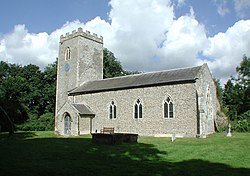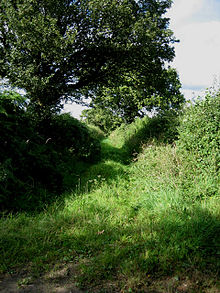Thurning, Norfolk
| Thurning | |
| Norfolk | |
|---|---|
 St Andrew, Thurning | |
| Location | |
| Grid reference: | TG080295 |
| Location: | 52°49’24"N, 1°5’13"E |
| Data | |
| Population: | 43 (2001) |
| Post town: | Dereham |
| Postcode: | NR20 |
| Dialling code: | 01263 |
| Local Government | |
| Council: | North Norfolk |
| Parliamentary constituency: |
North Norfolk |
Thurning is a small village in northern Norfolk. It lies near Corpusty, seven miles south of Holt, and nine miles northwest of Aylsham.
Thurning hardly earns the name of village; it has no core and consists chiefly of farms and houses which are well spaced from each other. The soil is mixed, the subsoil clay and sand. The parish includes the small hamlet of Craymere Beck.
In his Topographical Dictionary of England (1848), Samuel Lewis says:[1]
THURNING (St. Andrew)... comprises 1584a. 1r. 19p., of which 1,200 acres are arable, 300 pasture and meadow, and 80 plantation. The surface is agreeably undulated, and the high grounds command fine views of the picturesque scenery within and around the parish, which is remarkable for the number and variety of wild flowers with which its meadows are studded.
History
At the time of the Domesday Book (1086), Thurning was recorded as 'Tyrninga', suggesting an O)ld English original Þyrningas; "the place of Thyrn's clan". Charles Parkin writes interpreting the Domesday Book entry:
The principal lordship of this village was, at the survey, farmed of the Conqueror, or took care of by Godric his steward, Ulf, a Saxon, lord of it in the days of King Edward, being deprived, when one carucate of land and 6 villains, 9 borderers, and one servus belonged to it; there were 2 carucates in demean, one and an half among the tenants, with 10 acres of meadow, &c., the moiety of a mill, 4 runci, 20 cows, &c., and 50 sheep; and 6 socmen had 16 acres of land, and a carucate and an half. The soc belonged to the King's manor of Folsham; it was at that time valued at 60s. at the survey at 100s. quit-rent, and 10s. as a present, or free gift, was 5 furlongs long and 6 broad, and paid 5d. to the King's gelt.[2]
In 1659, Peter Elwin of Thurning (1623–1695) married Anne Rolfe, the elder daughter of Thomas Rolfe, who was the son of John Rolfe and his wife Pocahontas. John Rolfe was originally from Heacham in Norfolk, and his granddaughter Anne was brought up there.[3][4]
A good deal of research into local and family history has been undertaken in this wee village. Parish registers survive only from the early 18th century. Registers deposited in the Norfolk Record Office are for baptisms (1707, 1715–2006), marriages (1717–1739, 1758–2004), burials (1716–2006) and banns (1758–1822). However, some Archdeacons' and Bishops' transcripts survive, copies of register entries for years as far back as 1600.[5]
According to William White, a good new rectory was built in 1827. Samuel Lewis calls this "a handsome house erected in 1832".[1]

William White's History, Gazetteer, and Directory of Norfolk (1835 edition) says of Thurning:[6]
THURNING, or Thirning, is a parish of dispersed houses, 6 miles S. of Holt, and 4½ miles N. of Reepham, with 140 inhabitants and about 1,500—acres of land. W. E. L. Bulwer, Esq., is lord of the manor, (fine arbitrary.) A great part of the soil belongs to Hastings Elwyn, Esq., the owner of Thurning Hall, a neat mansion, with a fine lawn and small lake, and now the residence of James Gay, Esq. Mr. J. R. Barber, J. Richardson, Esq., and some others, have estates here. CRIMER'S BECK gives name to a hamlet on the north side of the parish. The CHURCH, dedicated to St. Andrew, has a nave, north aisle, and tower, with three bells, and had formerly a chancel. It was new roofed about ten years ago. The rectory, valued in K. B. at £7, is in the gift of Christ College, Cambridge, and incumbency of the Rev. Henry Wm. Blake, whose residence was rebuilt about four years ago. Directory - Thos. Frost, vict., Plough; James Gay, Esq.; Thos. Paul, shopkeeper; Hy. Pointin, blacksmith; Wm. Reynolds, miller; Samuel Rider, shoemaker; and Jas. Rech Barber, Richard Harvey, James Margarson, John Pye, John Sewell and Daniel Sidney, farmers.
Parish Church
The parish church, St Andrew's, looks at first sight like a typical mediæval church. It stands alone, isolated from other buildings, on the Reepham Road and about a quarter of a mile north of The Rectory. Nearby is the former stable of the Rector, who sometimes lived at Wood Dalling. The church lacks a chancel, this having been demolished early in the 18th century. The east window has cross-linked tracery, clearly used to fill the arch of the lost chancel, and the east end of the north aisle has an unusual rectangular window.[7]
In 1823, the church gained the furnishings of the old chapel of Corpus Christi College, Cambridge, when that was demolished; the Collage was the proprietor of the living. The aisle and the west end are filled with 18th century box pews, and the interior is dominated by a huge three-deck pulpit at the east end of the church, designed by James Burrough. On each of the box pews, a sign gives the name of the property in the parish which paid rent for it. The middle of the church contains plain benches, the sanctuary has communion rails, and the south wall a line of hat pegs. Also on the south wall and in the sanctuary are several 18th century memorials.[7] About 1833, the building was thoroughly restored.
Thurning Hall
Thurning Hall is an 18th century country house with a walled garden, set in 40 acres and surrounded by woodland. A large square three-storey Georgian building, it remains a private house but can be hired for weddings.[8][9]
Benjamin Clarke's British Gazetteer of 1852 wrroteof Thurnin Hall:
The Hall, a pleasing mansion, is the seat of James Gay, Esq., the representative of an ancient family which originally came from Normandy and were settled early in the time of Elizabeth at Matlask and Thurgarton, in which and the adjoining parishes they possessed considerable landed estates. Mr. Gay of Thurning, who is the second son of the late John Gay, Esq., settled at Thurning: and having been under-secretary of Ceylon, and commissioner for the Kandian provinces, is now a magistrate and deputy lieutenant for the county.
Kelly's Directory, 1883, says:
The Hall, the seat of James Gay esq jun. B.A., D.L., J.P. is a mansion which stands upon rising ground, surrounded by trees: the river Thurn, which flows through the park, expands into a lake within it: the view from the front of the Hall is very fine. Some curious flint hatchet-heads and some Druidical remains have been dug up in the grounds of the Hall.[10]
In 1996, the Hall was one of the locations for the filming of a BBC television version of George Eliot's The Mill on the Floss.[11]
Mills
During the first quarter of the 19th century, Thurning Tower Windmill worked closely with Thurning Water-mill. From auction particulars of 1826, it appears that each mill powered two sets of stones. Bryant's map (1826) shows the windmill immediately to the north of the water-mill and marks them together as 'Union Mills', which infers that they worked together.[12]
Outside links
| ("Wikimedia Commons" has material about Thurning, Norfolk) |
- Thurning Church Website - Reepham Benefice
- Thurning War Memorial at roll-of-honour.com
- Photograph of St Andrew's Church, Thurning on Geograph.org.uk
- Photographs of interior of Thurning Hall, at lightlocations.com
- Photograph of Lake in front of Thurning Hall, near to Foundry Hill, at geograph.org.uk
- Photograph of Reepham Road past Thurning Hall, at geograph.org.uk
- THURNING CENSUS 1841 Surname Index at kingslynn-forums.co.uk
References
- ↑ 1.0 1.1 Lewis, Samuel, A Topographical Dictionary of England (1848), pp. 351–355 at british-history.ac.uk. Retrieved 18 July 2008.
- ↑ Parkin, Charles, An Essay Towards a Topographical History of the County of Norfolk, vol. VIII (London: William Miller, 1808)
- ↑ Weatherwax, Esmerelda, Pocahontas in England, dated Oct. 2007, at newenglishreview.org. Retrieved 18 July 2008.
- ↑ Pocahontas at threlkeld.org.uk. Retrieved 18 July 2008.
- ↑ Parish Registers and Transcripts in the Norfolk Record Office at archives.norfolk.gov.uk. Retrieved 16 July 2008.
- ↑ White, William, History, Gazetteer, and Directory of Norfolk, and the City and County of the City of Norwich (Sheffield, Wm. White, 1835) page 358 online at books.google.co.uk. Retrieved 17 July 2008.
- ↑ 7.0 7.1 Knott, Simon, St Andrew, Thurning dated July 2006 at norfolkchurches.co.uk. Retrieved 16 July 2008.
- ↑ Thurning Hall
- ↑ Sayer, Michael, 'Thurning Hall' in Burke's & Savills Guide to Country Houses: Volume III, East Anglia (Burke's Peerage, 1981)
- ↑ Kelly's Directory of Norfolk, 1883
- ↑ Norfolk at walkingworld.com. Retrieved 18 July 2008.
- ↑ Thurning towermill at norfolkmills.co.uk. Retrieved 16 July 2008.
